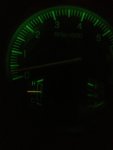petemaresco
New Member
- Joined
- Nov 16, 2012
- Messages
- 6
- Reaction score
- 0
- Points
- 0
- Vehicle Year
- 1988
- Make / Model
- Ford
- Transmission
- Manual
So last night I put a new MAP sensor, both upper and lower coolant temp sensors and the fuel pressure regulator. Also a new thermostat. I did all this because I'm moving to Austin on Sunday and I'm driving the truck there.
Before all this was done, the gauge needle was always below the center line. Usually on the "A" of "Normal". After doing all this work, it is much higher. usually between the O and the R, but at lowest its just at or slightly above center. It also warms up super fast, within 3 minutes.
Today, it did something ive never seen before. The outlet hose from the heater core and the upper radiator hose, both of which go to the thermostat housing, were sucked of all air and coolant and looked like you took a straw, plugged one end and then sucked the air out of it. They eventually went back to normal, but everything was still super hot. the radiator, hoses, everything. I put a second new thermostat in just to eliminate a bad thermo. It doesnt seem to be doing it now, but with the temp running as high as it is, i can't help but think its related.
I'm leaving in 36 hours and I desperately need to figure this out before I drive 1200 miles.
i took a photo and its seen as a thumbnail below, if that doesnt work, hopefully this thing i did below gives and idea.
-------
N
O________________this is where it is now, after the work.
R___
M________________this is where it was before
A
L
---------
Before all this was done, the gauge needle was always below the center line. Usually on the "A" of "Normal". After doing all this work, it is much higher. usually between the O and the R, but at lowest its just at or slightly above center. It also warms up super fast, within 3 minutes.
Today, it did something ive never seen before. The outlet hose from the heater core and the upper radiator hose, both of which go to the thermostat housing, were sucked of all air and coolant and looked like you took a straw, plugged one end and then sucked the air out of it. They eventually went back to normal, but everything was still super hot. the radiator, hoses, everything. I put a second new thermostat in just to eliminate a bad thermo. It doesnt seem to be doing it now, but with the temp running as high as it is, i can't help but think its related.
I'm leaving in 36 hours and I desperately need to figure this out before I drive 1200 miles.
i took a photo and its seen as a thumbnail below, if that doesnt work, hopefully this thing i did below gives and idea.
-------
N
O________________this is where it is now, after the work.
R___
M________________this is where it was before
A
L
---------
Attachments
-
55.4 KB Views: 60















